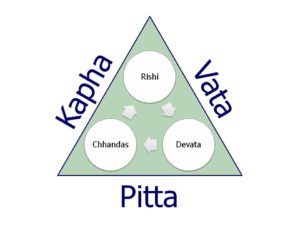
What are the Doshas?
The Doshas represent the most fundamental qualities of consciousness expressed in matter. They are the key to understanding our individual differences and how to harmonize with them to maintain stability in the face of a constantly changing environment.
The word Dosha literally means “impurity.” The Doshas are impure only in the sense that they are differentiated from the transcendental field of pure consciousness from which they arise. The Doshas govern the deepest levels of mind and body, but can still be appreciated on the surface. The three Doshas are interdependent. They are always present in varying proportions in all things.
Each of us was born with some mix of Doshas that describes our constitution or essential nature (Prakriti). Typically two Doshas have the most dominant influence. Less commonly, one Dosha predominates or all three have comparable weight. The totality of our life experiences and planetary influences modifies Prakriti over time.
The Importance of Balance
Even so, the real issue is balance. If our life experiences and habits of activity, sleep, and diet clash with Prakriti, then significant Vrikriti (deviation from Nature) can grow. Vrikriti is imbalance which sows the seed of disease. Thus, knowledge of your Prakriti can help you make better choices.
Health is a product of balanced Doshas, good digestion, well-functioning bodily tissues, proper elimination of wastes and inner peace. The state of balance of the Doshas is reflected in the radial pulse and other mind/body characteristics. It can often be inferred from symptoms.
I’ve oft repeated that to maintain balance, Ayurveda advises us to apply the principle of Similars (Samanya) and Opposites (Vishesh). As you would expect, Similars increase and Opposites decrease. Therefore, we need to understand the qualities that characterize the Doshas.
Qualities of the Doshas
By reading my prior posts, you would have absorbed a basic notion of these qualities without the labels. Vata represents movement. Pitta represents metabolism and transformation. Kapha represents structure. All heat comes from Pitta. Therefore, Vata and Kapha are both cold. Aside from that, they are polar opposites. Vata is subtle, light, quick, brittle, dry, bitter and rough-like old age and late fall /winter. Kapha is gross, heavy, slow, soft, oily, sweet and smooth-like childhood and spring.
You might better intuit the qualities of the Doshas by reflecting on the five “primordial” elements that characterize the next layer of creation. Vata gives rise to Space (Akasha) and Air (Vayu). Pitta gives rise to Fire (Tejas) and, in interaction with Kapha, to Water (Jal or Apas). Kapha gives rise to Earth (Prithivi) and Water. Expressions like “Air Head,” “Hot Head” and “Fat & Happy” say a lot about basic tendencies expressed when Vata, Pitta or Kapha dominate, but are not in balance.
Qualities of the Three Doshas |
||
| Vata | Pitta | Kapha |
| Cold | Hot, Warm | Cold |
| Light | Light | Heavy |
| Quick | Sharp | Slow |
| Dry, Rough | Fluid Flow | Sticky, Gluey |
| Subtle, Minute, Penetrating | Slippery, Slightly Oily | Oily, Unctuous |
| Clear, Non-Sticky | Sour, Acidic | Soft |
| Moving, Irregular | Liquid | Stable, Steady |
| Coarse, Brittle | Pungent, Scorching | Sweet |
Balancing the Doshas
Given these qualities, one would expect that heat, a calming, regular routine, and substances that promote heaviness and oiliness will balance Vata. This is the case. Similarly, moderation and cooling substances balance Pitta. In contrast, Kapha needs stimulation, warmth, dryness and lightening. It is balanced by exercise and by light, dry, heating, non-oily and rough substances.
If you get confused, innocently meditate on it. Health is always supported by growth of consciousness. (see Tissue Metabolism)
In the coming months, we’ll take a deeper dive into each of the Doshas.